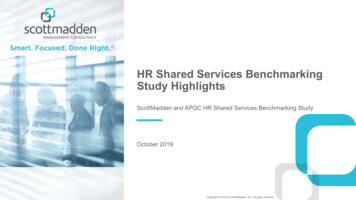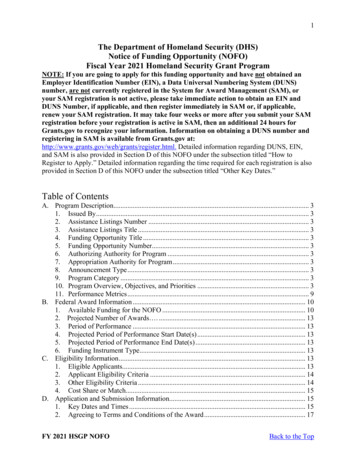
Transcription
Smart, Shared, and Social:Enhancing All-Hazards RecoveryPlans with Demand ManagementTechnologiesJANUARY 2020FTA Report No. 0151Federal Transit AdministrationPREPARED BYJohn MacArthurSustainable Transportation Program ManagerTREC at Portland State UniversitySarah J. SiwekSarah J. Siwek & Associates, Inc.
COVER PHOTOImage courtesy of Edwin Adilson Rodriguez, Federal Transit AdministrationDISCLAIMERThis document is disseminated under the sponsorship of the U.S. Department of Transportation in the interest of informationexchange. The United States Government assumes no liability for its contents or use thereof. The United States Governmentdoes not endorse products of manufacturers. Trade or manufacturers’ names appear herein solely because they are consideredessential to the objective of this report.
Smart, Shared,and Social:EnhancingAll-HazardsRecovery Planswith DemandManagementTechnologiesJANUARY 2020FTA Report No. 0151PREPARED BYJohn MacArthurSustainable Transportation Program ManagerTREC at Portland State University1900 SW Fourth Avenue, Suite 175Portland, OR 97207-0751Sarah J. Siwek, PresidentSarah J. Siwek & Associates, Inc.4519 Admiralty Way, Suite #140Marina del Rey, CA 90292-5441SPONSORED BYFederal Transit AdministrationOffice of Research, Demonstration and InnovationU.S. Department of Transportation1200 New Jersey Avenue, SEWashington, DC 20590AVAIL ABLE nnovationFEDERAL TRANSIT ADMINISTRATIONi
tricConversionTableWHEN YOU KNOWMULTIPLY BYTO mVOLUMEfl ozfluid ubic feet0.028cubic metersm3yd3cubic yards0.765cubic metersm3NOTE: volumes greater than 1000 L shall be shown in short tons (2000 lb)0.907megagrams(or "metric ton")Mg (or "t")TEMPERATURE (exact degrees)oFFahrenheit5 (F-32)/9or (F-32)/1.8CelsiusoCFEDERAL TRANSIT ADMINISTRATIONFEDERAL TRANSIT ADMINISTRATIONivii
REPORT DOCUMENTATION PAGEForm ApprovedOMB No. 0704-0188Public reporting burden for this collection of information is estimated to average 1 hour per response, including the time for reviewing instructions, searching existing data sources, gathering and maintaining the data needed, and completing and reviewing the collection of information.Send comments regarding this burden estimate or any other aspect of this collection of information, including suggestions for reducing thisburden, to Washington Headquarters Services, Directorate for Information Operations and Reports, 1215 Jefferson Davis Highway, Suite 1204,Arlington, VA 22202-4302, and to the Office of Management and Budget, Paperwork Reduction Project (0704-0188), Washington, DC 20503.1. AGENCY USE ONLY2. REPORT DATEJanuary 20203. REPORT TYPE AND DATES COVEREDFinal Report, November 2015–September 20194. TITLE AND SUBTITLESmart, Shared, and Social: Enhancing All-Hazards Recovery Plans with DemandManagement Technologies5. FUNDING NUMBERSOR-26-70126. AUTHOR(S)John MacArthur, Sarah J. Siwek7. PERFORMING ORGANIZATION NAME(S) AND ADDRESS(ES)TREC at Portland State University1900 SW Fourth Ave., Suite 175Portland, OR 97207-07518. PERFORMING ORGANIZATION REPORT NUMBER9. SPONSORING/MONITORING AGENCY NAME(S) AND ADDRESS(ES)10. SPONSORING/MONITORING AGENCY REPORTNUMBERFTA Report No. 0151U.S. Department of TransportationFederal Transit AdministrationOffice of Research, Demonstration and InnovationEast Building1200 New Jersey Avenue, SEWashington, DC 2059011. SUPPLEMENTARY NOTESFTA Report No. novation]12A. DISTRIBUTION/AVAILABILITY STATEMENTAvailable from: National Technical Information Service (NTIS), Springfield, VA 22161.Phone 703.605.6000, Fax 703.605.6900, email [orders@ntis.gov]12B. DISTRIBUTION CODETRI-3013. ABSTRACTThis report summarizes the activities and results of a project to develop an all-hazards emergency transportation recovery plan for Portland,Oregon. The first phase of the project was to develop, test, and refine an integrated all-hazards emergency transportation recovery plan, workingdirectly with organizations that are involved in transit and transportation demand management (TDM) in the Portland region. The key goal wasto address the need for post-disaster access and mobility when infrastructure capacity has been reduced by both damage and the needs ofemergency responders and recovery activities and to jumpstart the region on the road to social and economic recovery. The second phase of theproject was to develop a training course on emergency transportation recovery planning using the Portland plan as a prototype. The course wasoffered in six locations across the country. This project provides examples and tools for other regions and agencies to develop a transportationrecovery plan.14. SUBJECT TERMSRecovery, transportation, all-hazards, emergency planning, Portland, Oregon, training,safety, risk, TDM, ITS, social media15. NUMBER OF PAGES7116. PRICE CODE17. SECURITY CLASSIFICATIONOF REPORTUnclassified18. SECURITY CLASSIFICATIONOF THIS PAGEUnclassified19. SECURITY CLASSIFICATIONOF ABSTRACTUnclassified20. LIMITATION OF ABSTRACTNoneFEDERAL TRANSIT ADMINISTRATIONv
AcknowledgmentsThe project team would like to extend its thanks to all who have contributedto the completion of this project. This project would not have been possiblewithout the invaluable support of the City of Portland’s Bureau of EmergencyManagement for its participation and critical contributions of resourcesand expertise in furtherance of this effort, especially the support of JonnaPapaefthimiou. We would also like to thank the members of the TechnicalAdvisory Committee and the regional training leads and coordinators. Theknowledge and expertise of TriMet, especially Alex Ubiadas, was essential to thesuccess of this project.The authors thank the following individuals of the project team: Tanya Zwahlen,David Judd, Jason Pavluchuk, and Susan Hopkins; T.Y Lin Consultants (SorinGarber and Richard Perrin); and Sara Hendricks and Philip Winters of theUniversity of South Florida Center for Urban Transportation Research (CUTR).Additionally, we would like to thank Bill Keyrouze and Rachel Roper of theAssociation of Metropolitan Planning Organizations (AMPO) for their help on theproject.AbstractThis report summarizes the activities and results of a project to develop an allhazards emergency transportation recovery plan for Portland, Oregon. The firstphase of the project was to develop, test and refine an integrated all-hazardsemergency transportation recovery plan, working directly with organizationsthat are involved in transit and transportation demand management (TDM) in thePortland region. The key goal was to address the need for post-disaster accessand mobility when infrastructure capacity has been reduced by both damage andthe needs of emergency responders and recovery activities and to jumpstart theregion on the road to social and economic recovery. The second phase of theproject was to develop a training course on emergency transportation recoveryplanning using the Portland plan as a prototype. The course was offered in sixlocations across the country. This project provides examples and tools for otherregions and agencies to develop a transportation recovery plan.FEDERAL TRANSIT ADMINISTRATIONvi
TABLE OF CONTENTS1Executive SummarySection 1:Project BackgroundSection 2:Project Description17Section 3:Conclusion21Appendix A:Project Participants24Appendix B: Transit Operator Survey Responses Data62Glossary63ReferencesFEDERAL TRANSIT ADMINISTRATIONvii
EXECUTIVESUMMARYNatural disasters, acts of terrorism, and other emergency incidents can affectmultiple jurisdictions simultaneously. Major disasters, such as earthquakes,create large-scale impacts that require outside assistance even for the mostprepared local public safety and emergency management organizations. The cities,counties, non-governmental organizations, and business-sector stakeholders ina region recognize that they all can more effectively respond to emergenciesand facilitate recovery of communities if they prepare together. Regionalcollaboration in building disaster preparedness capabilities is more cost-effectivefor taxpayers, develops roles and relationships needed for efficient disasterresponse and recovery, and increases the ability to involve the whole communityin preparedness initiatives. During the past few decades, a number of naturaldisasters and other emergencies have occurred in various regions in the U.S.,and the resulting impacts on the transportation system have been significant.In each case, transportation system impacts included damage to highway andtransit infrastructure and significant disruption in travel. A vital component of anemergency management and recovery framework is the transportation network.Transit agencies play an important part in all phases of emergency management.Transit has a role to play in mitigation by protecting its own assets andestablishing redundant communication systems to help ensure continuity ofservice. It is crucial that transit agencies should be part of preparedness plans andrepresented in the emergency command structure. Transit also plays a vital roleduring the response phase, by both helping to evacuate those without access to aprivate vehicle and bringing emergency responders and equipment to the incidentsite. Finally, they can be involved in the recovery phase, reestablishing normal oralternate transit operations and bringing evacuees back to the area.The Portland, Oregon, region has learned from past natural disasters andemergency events that there is a clear need for comprehensive emergencypreparedness and recovery plans that include robust and coordinated transitand transportation demand management (TDM) elements for the response andsubsequent recovery periods. The basic purpose of this project was to integrateorganizations that are involved in transit, transportation planning, and TDM withentities that are traditional emergency responders to develop a fully-integratedemergency recovery plan that includes transit providers, TDM providers, socialmedia, and ITS technologies.The first phase of this project was to develop, test, and refine an integrated allhazards emergency response and recovery transportation plan working directlywith organizations that are involved in transit and TDM in the Portland region.The key goal was to address the need for post-disaster access and mobility wheninfrastructure has been damaged, causing reduced capacity in the system. Thisall-hazards recovery project looked to guide the City of Portland and TriMet toplan on how they need to think about how the city and region would deploy theirhuman and physical capital with increased effectiveness before, during, and afterFEDERAL TRANSIT ADMINISTRATION1
EXECUTIVE SUMMARYan emergency. The second phase was to develop a training course on emergencytransportation recovery planning using the Portland plan as a prototype. Thecourse was tested in Portland, refined, and then offered in six locations acrossthe U.S. The project also included a phase for disseminating lessons learnedthrough research, planning, and tabletop exercises.Key Outcomes of the ProjectRecovery is the process of reasonably restoring expected economic and socialfunctions of a community following a natural or human-induced hazard event.The Portland Transportation Recovery Plan provides an integrated processand associated actions for the City of Portland to transition from emergencyresponse procedures after a disaster event to mobility recovery strategiesemphasizing the use of transit, TDM, social media, and intelligent transportationsystems (ITS) technologies.The Portland Transportation Recovery Plan wasdeveloped to focus on transportation recoveryand was the first type of plan to focus onrecovery in the region. As the City of Portlandand the greater Portland metropolitan regiondevelop broader regional recovery plans, it willbe important to align future transportationrecovery efforts with the vision and goalsof those plans. One of key outcomes of theproject was the acknowledgement that thefields of transportation planning and emergencymanagement (personnel and departments) donot typically interact together. The planningprocess and trainings brought these individualsand departments together to work on recovery planning. A significant outcomeof the project was the enhanced relationships with these agencies and individualsand increased understanding of the priorities, needs, and language used.Going forward, the City of Portland will work with TriMet and other agencies todevelop a broader infrastructure recovery framework and governance strategybased on changes in technology, internal capacity, and other factors that directlyinfluence the ability to restore and improve the pre-event functioning of the city’stransportation system. This will allow the Plan to take advantage of improvedconditions and future investments, include actions that more explicitly integratefreight and goods movement, and integrate additional organizations from the notfor-profit and private sectors. Because of their regional scope, TriMet, Metro,and the Regional Disaster Preparedness Organization (RDPO) are ideal to leadthe efforts outside of Portland and help create a regional transportation recoveryplan.FEDERAL TRANSIT ADMINISTRATION2
EXECUTIVE SUMMARYAnother goal was to disseminate the lessons learned from developing and testingPortland’s plan and share the experience by training relevant partners in sixU.S. cities. The purpose of the training was to provide participants with thetools, knowledge, skills, and resources to develop an emergency transportationrecovery plan that includes coordinated public transportation services, TDM, andITS strategies and recognizes the specific needs, resources, and relationships withemergency responders within each region. In total, 247 people participated in thetrainings. A year after the training, two regions have made significant progress indeveloping transportation recovery plans and activities.Key Findings in Transportation RecoveryPlanningBased on a comparison of the content of existing regional transportation andemergency management plans and interviews with staff from agencies andorganizations in the region and across the U.S., Federal guidance, and otherresearch, several key findings from this project emerged: Recovery is not clearly understood. Most resources reviewed includeda definition of recovery and discussed the differences between recoveryand emergency response. The interviews and discussions with trainingparticipants demonstrated that the words “recovery” and “response” areoften used interchangeably by many agency personnel. It is important thata plan clearly defines recovery and its place in the emergency managementprocess while recognizing the overlap with response. There are limited examples of transportation recovery plans and aneed for training. There are few examples of transportation recovery plansin place, and there is a demonstrated need shown by project participants formore guidance. Developing a database of recovery cases, examples, tools, andplans would help agencies, cities, and regions learn from others. In addition,there is limited training on the topic of transportation recovery planning. Transit agencies need to be an important part of the planning.During large-scale emergency events, transit plays a crucial role in themovement of people, especially those in underserved communities, andcan play important roles in recovery after specific types of disasters inhelping communities restore life-sustaining services and access to jobs.Transit effectiveness will depend upon, first, what these organizations doto fortify their internal continuity of operations; second, what transit do toanticipate and prepare effective responses to the consequences of multiplesimultaneous threats; and third, how well recovery plans are implemented. Different stages of recovery require different actions and protocols.Multiple resources reviewed acknowledge that recovery is a longerprocess than response. A transportation plan should lay out the roles andresponsibilities of all public and private organizations across the stages ofFEDERAL TRANSIT ADMINISTRATION3
EXECUTIVE SUMMARYrecovery and link to additional recovery activities such as housing, economicdevelopment, and utilities. Long-range planning should be more prominent in transportationrecovery. Response planning is more closely aligned with emergencymanagement, and recovery planning is more closely aligned with longrange planning. Departments of transportation and transit agencies shouldincorporate recovery as criteria in long-range plans so key infrastructure,corridors, and assets are made resilient for events. Often, existing transitroutes can offer a network from which to build recovery efforts, and theseroutes need to be resilient and adaptable. Performance measures need to be developed as part of theplanning process. Cities and regions that develop transportation recoveryplans will want to consider how to evaluate their efforts. Performancemeasures for safety and operational/capital efficiency can be identified togauge transit losses avoided due to institutional preparedness and to gaugecommunity losses avoided due to transit preparedness to support recoveryefforts.The examples, tools, recommendations, and insights produced by this projectmay also provide inspiration and guidance to other regions and transportationand transit agencies in the U.S. that seek to develop their own transportationrecovery plans. The work generated by the individuals in Portland can serve asan example for others to start working on this key component of emergencymanagement. The challenges, barriers, and lessons learned detailed in this reportand the associated documents are common to other regions, as noted during thetrainings. This project can help move forward the much-needed efforts in the U.Sof transportation recovery planning.FEDERAL TRANSIT ADMINISTRATION4
SECTION1Project BackgroundIn 2013, the Federal Transit Administration (FTA) published a Notice of FundingAvailability (NOFA) in the Federal Register that announced 29 million in funds forInnovative Safety, Resiliency, and All-Hazards Emergency Response and RecoveryResearch (SRER) projects of national significance [1]. In 2015, FTA awarded Portland State University 943,984 to develop and test a transportation recoveryplan for the Portland metropolitan area. This funding was matched with 131,868of local and in-kind effort. The objective of the project looked to help the City ofPortland, TriMet (Portland’s public transit agency), and other regional transportation and emergency management agencies to develop a plan to deploy transportation services and personnel with increased effectiveness after an emergency.During the past few decades, a number of natural disasters and other emergencies have occurred in various regions in the U.S., and the resulting impacts on thetransportation system have been significant. Examples of such incidents include: 9/11 attack (NY-NJ) – 2001 Hurricane Katrina (LA) – 2005 Hurricane Rita (TX) – 2005 Hurricane Sandy (NY–NJ region) – 2012 Boston Marathon bombing (MA) – 2012 Northridge earthquake (CA) – 1994In each case, transportation system impacts included damage to highway andtransit infrastructure and significant disruption in travel. These events have ledto short- and long-term changes in travel patterns and travel modes, includingcommute trips. Examples of the impacts of these disasters include the following: The 9/11 attack disrupted the transit system, including New YorkMetropolitan Transportation Authority (MTA), Port Authority Trans-Hudson(PATH), and New Jersey TRANSIT. Rebuilding has been underway since2001. This event dramatically changed travel patterns for tens of thousandsof people. Hurricane Katrina caused major damage to the transit system due toflooding on the light rail line and in rolling stock storage locations. Theextensive damage to the transit system dramatically hindered recoveryefforts for thousands of transit-dependent people. Hurricane Sandy caused major disruption due to flooding throughout theNew York and New Jersey regional transit systems and at rolling stockstorage and maintenance facilities. The New York subway is still dealingFEDERAL TRANSIT ADMINISTRATION5
SECTION 1: PROJECT BACKGROUNDwith the damage caused by the event and has spent more than 5 billion onrepairs and upgrades. Hurricane Rita prompted a directive from the Governor of Texas to theHouston region’s Metropolitan Planning Organization (Houston-GalvestonMPO) to take the lead among regional agencies to develop an emergencyevacuation plan. This directive was issued after Hurricane Rita due tosignificant difficulties with evacuation of residents in preparation for theHurricane. The Boston Marathon bombing caused immediate impacts on the transitsystem, and the subsequent manhunt caused even more substantial traveldisruption.FTA defines “all-hazards preparedness” as “integrated planning and capability building for safety, security, and emergency management to optimize andcontinuously improve the use of resources and the management of risks fromhazards, threats, vulnerabilities, and adverse events or incidents” [2]. Becauseof past emergencies and the damage caused, transportation and transit agenciesthroughout the U.S. have efforts underway to improve system resiliency and better protect infrastructure during emergencies. Disaster and emergency eventscan have long-lasting impacts on transportation infrastructure and mobility inthe impacted region and have reinforced the need for comprehensive emergencypreparedness plans that include strong transportation elements for the immediate response and subsequent recovery period.The National Disaster Recovery Framework constructs recovery efforts in tofive phases: preparedness disaster (or adverse incident), short-term recovery,medium-term recovery, intermediate-term recovery, and long-term recovery [3].The three post-event phases overlap as well as merge into each other; however,the division is used throughout recovery preparedness literature to describe certain discrete functions that vary during the recovery periods, such as assessment,debris removal, infrastructure repair, and operational planning.Transit agencies play an important part in all phases of emergency management.Transit has a role to play in mitigation by protecting its own assets and establishing redundant communication systems to help ensure continuity of service. It iscrucial that transit agencies should be part of preparedness plans and represented in the emergency command structure. Transit also plays a vital role during theresponse phase, in both helping to evacuate those without access to a privatevehicle and bringing emergency responders and equipment to the incident site.Finally, they can be involved in the recovery phase, reestablishing normal or alternate transit operations and bringing evacuees back to the area.Many U.S. cities, regions, and states have developed emergency preparednessand response plans, but there have been only few examples of efforts focusing onrecovery planning, especially transportation planning. In 2014, the Puget SoundTransportation Recovery Annex was developed as part of the Regional Cata-FEDERAL TRANSIT ADMINISTRATION6
SECTION 1: PROJECT BACKGROUNDstrophic Disaster Coordination Plan for the Puget Sound, Washington, region [4].While providing recommended guidelines for coordinating multi-jurisdictional regional transportation system recovery after a major earthquake, it also includesguidance to local governments to develop their own plans and is applicable toall events that disrupt multiple modes of transportation. Nine appendices of theplan present detailed information on several topics, including alternative routingmaps; prioritization of roadways for restoration and reconstruction; assessmentand mitigation strategies for roadways, waterways, and airways; and recommendations for training capabilities and exercises to be conducted in advance of anevent.On July 1, 2013, Bay Area Rapid Transit (BART), the public transportation systemin the San Francisco Bay Area, shut down as unionized workers began a strikedue to the inability to reach an agreement with management on new contracts.As the fifth largest such system in the U.S., 400,000 commuters were forced tofind new means of getting themselves to and from work, school, medical appointments, and other activities. Short-term contract extensions and intermittentstoppage in services continued through the better part of October 2013. TheMetropolitan Transportation Commission (MTC), the MPO for the San FranciscoBay Area, produced a summary of the strike that included the events leading upto the strike, coordination conducted by MTC, responses by regional partners,the financial costs of the strike, and lessons learned. In addition, a “playbook” fortransportation disruptions on the San Francisco–Oakland Bay Bridge Corridorwas developed (MTC owns, maintains, and operates that bridge) [5]. The playbook helps agencies address an incident by identifying the type (human-inducedor natural), selecting appropriate mitigation measures and public outreach tacticsand tools for the specific incident, and providing guidance on how to implementthe mitigation measures and public outreach. The playbook also includes information on resource and procurement challenges and a schedule for its update.The U.S. Department of Transportation (U.S. DOT) has published two documents that were consulted during the project. Recovering from Disasters is aframework for transportation industry stakeholders, local governments, andstate/tribal governments to employ following an incident that will result in moreresilient transportation networks [6]. It includes thorough listings of fundingresources from U.S. DOT and other Federal departments and the respective roles and responsibilities offederal agencies during recovery. Recovery ResourceGuide: A Transportation Stakeholder Guide to Recovery [7]is cited by U.S. DOT as the update to its Recoveringfrom Disasters. However, the bulk of the documentupdates statutory references to the Federal surfacetransportation authorization enacted in 2012 and buildson the original strategy through expanded discussionsof Federal directives and U.S. DOT support functions.FEDERAL TRANSIT ADMINISTRATION7
SECTION 1: PROJECT BACKGROUNDAdditional resources used in the development of theframework of the plan were TRB Special Report 294:The Role of Transit in Emergency Evacuation [8] and National Cooperative Highway Research Program Report 753:A Pre-Event Recovery Planning Guide for Transportation [9].TRB 294 focuses on the evacuation of urban areas aftermajor incidents and how transit agencies could play asignificant role in an emergency evacuation, particularlyin transporting carless and special-needs populations.The report provides a framework and recommendations for transit and other public transportationproviders in such an incident. NCHRP 753, publishedin 2013, is a technical guidance for the preparation ofa transportation recovery plan. Whereas it providesan overview of Federal frameworks and directives anddiscusses funding programs, its greatest utility is in itsidentification of pre-incident recovery planning principles, effective practices following previous incidents,key tasks of recovery planning, and communication andcollaboration models.In the last decade, social media has emerged as a powerful, real-time communications tool that can transform how people travel. Additionally, ITS technologieshave become increasingly sophisticated and are anintegral part of the investment portfolio of transportation and transit agencies. ITS technologies have vastlyimproved the operations and management capabilitiesof transportation system managers and provide valuable data that can be used in planning activities and inanalyzing system performance.The Portland region has learned from past natural disasters and emergency events that there is a clear needfor comprehensive emergency preparedness and recovery plans that include robust and coordinated transitand TDM elements for the response and subsequent recovery periods. The basicpurpose of this project was to integrate organizations that are involved in transit,transportation planning, and TDM with entities that are traditional emergencyresponders to develop a fully-integrated emergency recovery plan that includestransit providers, TDM providers, social media, and ITS technologies.FEDERAL TRANSIT ADMINISTRATION8
SECTION2Project DescriptionProject SummaryThe purpose of this project was two-fold. The first phase was to develop,test, and refine an integrated all-hazards emergency response and recoverytransportation plan working directly with organizations that are involved intransit and TDM in the Portland region. The key goal was to address the needfor post-disaster access and mobility when infrastructure has been damaged,causing reduced capacity in the system. This all-hazards recovery project lookedto guide the City of Portland and TriMet to plan on how they need to thinkabout how the city and region would deploy its human and physical capital withincreased effectiveness before, during, and after an emergency.The second phase was to develop a training course on emergency transportationrecovery planning using the Portland plan as a prototype. The course wastested in Portland, refined, and then offered in six locations across the U.S. Theproject also included a phase for disseminating lessons learned through research,plann
This report summarizes the activities and results of a project to develop an all-hazards emergency transportation recovery plan for Portland, Oregon. The first . phase of the project was to develop, test and refine an integrated all-hazards emergency transportation recovery plan, working directly with organizations











